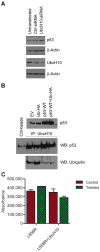The Interconnection Between UbcH10, p53, and EGFR in Lung Cancer Cells and Their Involvement in Treatment Response
- PMID: 40282365
- PMCID: PMC12026858
- DOI: 10.3390/genes16040404
The Interconnection Between UbcH10, p53, and EGFR in Lung Cancer Cells and Their Involvement in Treatment Response
Abstract
Background/Objectives: The UbcH10 protein plays an important role in a variety of human malignancies, including thyroid, breast, ovarian, and colorectal carcinomas. It has been previously reported that UbcH10 is overexpressed in non-small cell lung cancer (NSCLC) compared to normal lungs and that its expression is directly and inversely correlated with the mutational status of p53 and EGFR, respectively. Methods: We transfected lung cancer cells with wild-type and mutant forms of EGFR, modulated the expression of UbcH10 and p53, and treated these cells with tyrosine kinase inhibitor (TKI) erlotinib. Using Western blotting, we evaluated the expression of UbcH10 induced by EGFR and p53. Finally, we employed immunohistochemistry to assess the levels of UbcH10 expression in a subset of NSCLC patients receiving TKI therapy. Results: We reported a possible modulation of UbcH10 expression by the overexpression of wild-type and mutant EGFR in H460 lung cancer cells, potentially through p53. The enforced expression of UbcH10 in cells transfected with mutant EGFR suggested a potential increase in resistance to erlotinib treatment. Finally, immunohistochemical analysis of samples from NSCLC patients with mutant EGFR indicated a possible connection between UbcH10 expression levels and progression-free survival. Conclusions: In NSCLC, UbcH10 may play a role in the regulation of TKI response via a molecular pathway potentially involving p53 and EGFR. However, further research is needed to fully understand this mechanism.
Keywords: EGFR; UbcH10; adenocarcinoma; non-small cell lung cancer; p53; resistance.
Conflict of interest statement
U.M., Consulting or advisory role (unrelated to the current work): Boehringer Ingelheim, MSD, Roche, Amgen, Lilly, Thermo Fisher Scientific, Diaceutics, Merck, Glaxo Smith Kline, Astra Zeneca; Speakers’ Bureau (unrelated to the current work): Boehringer Ingelheim, Roche, AstraZeneca, MSD, Merck, Amgen, Thermo Fisher Scientific, Diaceutics, Lilly, Glaxo Smith Kline. F.P., Relationship unrelated to the current work (advisory fees, honoraria, grants, travel accommodation and expenses, and non-financial support) with Menarini and Roche. All other authors declare no conflicts of interest. The funder had no role in the design of the study; in the collection, analyses, or interpretation of data; in the writing of the manuscript; or in the decision to publish the results.
Figures





Similar articles
-
UbcH10 overexpression in human lung carcinomas and its correlation with EGFR and p53 mutational status.Eur J Cancer. 2013 Mar;49(5):1117-26. doi: 10.1016/j.ejca.2012.09.033. Epub 2012 Oct 24. Eur J Cancer. 2013. PMID: 23102841
-
Mediating EGFR-TKI Resistance by VEGF/VEGFR Autocrine Pathway in Non-Small Cell Lung Cancer.Cells. 2022 May 19;11(10):1694. doi: 10.3390/cells11101694. Cells. 2022. PMID: 35626731 Free PMC article.
-
[Molecular mechanism of erlotinib resistance in epidermal growth factor receptor mutant non-small cell lung cancer cell line H1650].Zhongguo Fei Ai Za Zhi. 2012 Dec;15(12):689-93. doi: 10.3779/j.issn.1009-3419.2012.12.02. Zhongguo Fei Ai Za Zhi. 2012. PMID: 23249714 Free PMC article. Chinese.
-
Strategies to overcome acquired resistance to EGFR TKI in the treatment of non-small cell lung cancer.Clin Transl Oncol. 2019 Oct;21(10):1287-1301. doi: 10.1007/s12094-019-02075-1. Epub 2019 Mar 12. Clin Transl Oncol. 2019. PMID: 30864018 Review.
-
First-line treatment of advanced epidermal growth factor receptor (EGFR) mutation positive non-squamous non-small cell lung cancer.Cochrane Database Syst Rev. 2021 Mar 18;3(3):CD010383. doi: 10.1002/14651858.CD010383.pub3. Cochrane Database Syst Rev. 2021. PMID: 33734432 Free PMC article.
References
-
- Reck M., Remon J., Hellmann M.D. First-Line Immunotherapy for Non–Small-Cell Lung Cancer. J. Clin. Oncol. 2022;40:586–597. - PubMed
MeSH terms
Substances
Grants and funding
LinkOut - more resources
Full Text Sources
Medical
Research Materials
Miscellaneous

